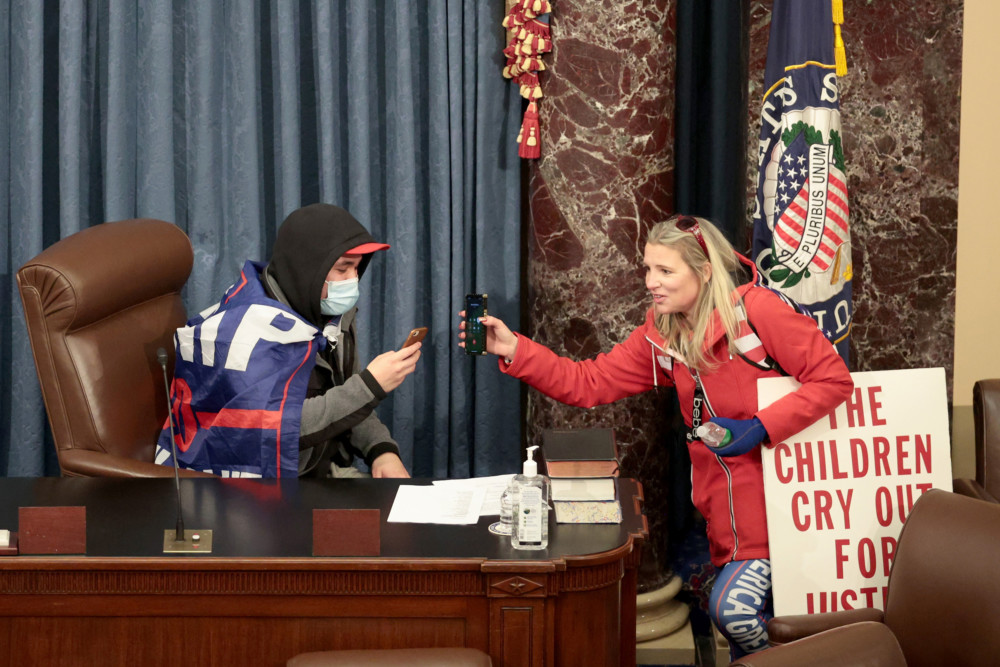By Todd J. Gillman
The Dallas Morning News
WWR Article Summary (tl;dr) The final count could take days as it will take some time to count all those mail-in ballots. As Todd Gilman reports, “In some states, processing started weeks ago and will be done by the time polls open. In others, the work can’t even start until polls close Tuesday night.”
Washington
Who won? When will we know? Can we trust that result?
Enormous uncertainty hangs over Election Day in a nation in the throes of a pandemic.
Maybe we’ll know by the wee hours Wednesday morning. But there’s a good chance it will take several days, at least, until enough votes are counted in enough states to know beyond reasonable dispute whether President Donald Trump gets to stay in the White House or if former vice president Joe Biden has sent him packing.
From Hawaii to Maine, election workers will be opening huge stacks of envelopes and comparing names to registries. As of Monday, nearly 30 million mail ballots were still outstanding, according to the U.S. Elections Project – ballots that voters requested in previous weeks that might still come back in time to be counted. In some states, processing started weeks ago and will be done by the time polls open. In others, the work can’t even start until polls close Tuesday night.
The organizations representing state elections officials have pleaded for patience, reminding a restless public that the unexpected can occur in any election, regardless of how mundane or bitter.
Polling sites open late. Workers don’t show up. Equipment malfunctions. But election officials from across the country say these problems don’t mean there is malicious activity.
“We want voters to have confidence in the process…and have patience as election officials tally, canvass and certify election results,” said New Mexico’s Maggie Toulouse Oliver, president of the National Association of Secretaries of State.
SCENARIOS FOR AN EARLY NIGHT
There are scenarios in which the results are clear and quick. All involve a win for Biden, as forecasters see only a narrow path to victory for Trump.
One involves Texas. A win for Biden would stop Trump cold. Another involves Florida and Pennsylvania going decisively for the Democrat.
Florida starts counting absentee ballots far in advance of Election Day, and could be called Tuesday night. Pennsylvania, however, is more problematic. There, workers cannot even open the ballots until polls close.
Polls show Biden stretching his leads nationally and in critical battlegrounds in the final days. Trump eked out a win in 2016 by just 80,000 votes combined in Michigan, Pennsylvania and Wisconsin, where his victory margins ranged from 0.2% to 0.8%.
They’re all battlegrounds again this year, and Trump’s chances grow if he can keep them in his camp.
But the count could take days, thanks to the huge surge in absentee ballot requests.
States expanded mail-in voting so voters wouldn’t have to crowd together on Tuesday in school cafeterias and libraries and community centers. Processing and counting those ballots takes time – just as it takes time at the polling site for clerks to match your name to a list.
Wisconsin doesn’t allow election workers to start processing until polls open. Counting starts after polls close.
Michigan should deliver its tally sooner. There, state law allows workers to open and verify mail ballots starting on Monday, though counting has to wait until polls close.
“If Pennsylvania and Wisconsin have stacks and stacks of mail-in ballots in all their different counties that the processing boards can’t start sifting through until Election Day, that work may take several days,” said Steven Huefner, deputy director of the election law program at Ohio State’s Moritz College of Law.
Workers have to open the envelope, match the information with a database to make sure the voter is eligible and only cast one such ballot. Each step takes time.
Democrats have been more likely to vote absentee ballots, since Trump has spent months trash talking mail-in ballots. That means tallies that only include votes cast on Election Day will be incomplete and could be skewed toward Republicans.
The variety of rules in other battlegrounds means a guessing game as to when either candidate might hit critical mass and clinch.
— Arizona and Florida: Early returns are likely to favor Biden, because mail ballots can be counted starting weeks before Election Day, and Democrats are more likely to vote by mail.
— Georgia: Biden has been on offense. Officials expect full results to take a couple of days. Counting of mail ballots can’t start until polls close.
— Iowa: State law allows processing to start Saturday, and ballots can be counted on Monday. Results are expected Tuesday night.
— North Carolina: Election offices have been processing mail ballots for a month. Officials expect more than 98% of the vote to be reported on Election night.
Unless the winds are blowing hard in one direction, a concession isn’t likely right away.
Trump has underperforming his 2016 pace by 3 to 8 points, according to a leading nonpartisan handicapper, Charlie Cook, and the prospects for a contested election grew dimmer in the past week with “every day that Trump remains behind in the polls, outspent badly and with the early vote gushing in.”
Hillary Clinton also led in the final days four years ago, though Biden is in stronger position than she was. The president could defy the odds again if enough “shy” Trump voters are out there – supporters reluctant to admit their leanings to pollsters. He trails only narrowly in Florida. He won there and in Pennsylvania last time and if they stick with him, he can win another term.
In Texas, state GOP chairman Allen West does not expect defeat.
“Our goal is to win big so we don’t have anything to contest,” he said. “I’m planning on overwhelming the opposition…. I’m not planning on anything being close.”
WHO MAKES THE CALL?
The news media has no legal authority to declare a winner, of course, though the public looks to the Associated Press and TV networks to do so.
Their formulas vary.
The gist is that they make projections once the margin of victory is big enough compared to the number of uncounted votes.
Once enough states are called, it’s a question of simple arithmetic.
There are 538 electoral votes up for grabs, including 38 from Texas. The first one to 270 wins.
As a constitutional matter, though, there is no president-elect until the electors gather as the Electoral College on Dec. 14.
“Responsible media will not be reporting on election night unless there’s a huge wave. They’ll say we have x% of the vote in, and x% out,” said Rachel Kleinfeld, a member of the National Task Force on Election Crises, a nonpartisan group of experts in elections, national security and cybersecurity, and a senior fellow at the Carnegie Endowment for International Peace. “I wouldn’t expect a concession from either side if things were close.”
Americans have grown used to finding out the winner on Election night, even if it’s not until the wee hours. But it doesn’t always work out that way.
In 1960, NBC News didn’t declare John F. Kennedy the victory until 7 a.m. the next day. His 303-219 Electoral College landslide concealed a razor thin race in which he topped Richard Nixon by just 112,000 votes out of 68 million.
Two close calls alone could have swung the outcome: Texas, which Kennedy carried by 46,257 votes, and Illinois, where he won by 8,858 out of nearly 4.8 million. Republicans suspected theft by the Daley machine in Chicago, or by Kennedy’s running mate Lyndon Johnson, who famously won a Senate primary in Texas in 1948 when 200 extra votes turned up from Duval County’s Precinct 13.
Fresher in memory is the Florida recount of 2000, a 36-day ordeal that ended with Texas Gov. George W. Bush beating Vice President Al Gore by 537 votes, when a 5-4 Supreme Court halted the recount.
In 2018, nearly two dozen U.S. House races couldn’t be called on election night.
In California’s Central Valley, one race was so close the outcome wasn’t clear for three weeks. The three-term incumbent led by 4,400 votes on election night and AP declared him the winner. But the lead disappeared as mail ballots were counted. The challenger ended up winning by 862 votes. He’s now the incumbent in a bitter rematch.
“Californians know and Arizonans know that that is democracy playing its course,” said Lucinda Guinn, an El Pasoan who serves as executive director of the Democratic Congressional Campaign Committee. “That is ballots being counted… and there is not panic about the election.”
In a recent survey of six battleground states, overwhelming bipartisan majorities – upwards of 74% – said it’s more important to get an accurate vote count, even if that takes a few days, than to know the outcome on election night.
Only a quarter expect vote-counting to be complete that night.
Trump has repeatedly questioned the legitimacy of mail ballots, and falsely claimed that it’s illegal to count ballots after Election night – as more than 20 states do under their individual election laws.
Most states that accept mail ballots after Election Day do so for a week or less. Just three have a two-week window, and all are so far out of reach for Trump that late votes can’t possibly make a difference: California, Illinois and Washington.
“It would be very, very proper and very nice if a winner were declared on Nov. 3 instead of counting ballots for two weeks, which is totally inappropriate, and I don’t believe that that’s by our laws. I don’t believe that,” Trump said Tuesday on his way to Michigan – where mail ballots aren’t counted before Election Day, and officials say they may need three days to report complete unofficial tallies.
Kleinfeld, the election expert from the Carnegie Endowment, called the stance extraordinary.
“We’ve never had a president say ahead of time that he might not accept the results or that an election is likely to be fraudulent,” she said.
TEXAS RESULTS
Polls in Texas have been tight. Biden and Trump have traded leads, as the state emerged as a true battleground for the first time in a generation.
Still, there should be enough votes counted by late Tuesday to know who won – barring an incredibly tight race or catastrophic failure in a major county.
If Trump carries Texas, as every GOP nominee has since 1980, the suspense continues nationwide.
If Biden pulls off a win, the contest will be over. Republicans have no realistic way to get enough electoral votes without Texas.
Texas Democrats are optimistic, and they’re girding for legal fights in response to voter intimidation or any potential violations.
“Everyone is on standby to react to whatever the Republicans do. We know they’re going to try something. They already are,” said state party chairman Gilberto Hinojosa.
Texas will not be one of the last states to be called, even though turnout is smashing records.
More Texans cast ballots early than in all of 2016. That mark fell with one more day left in early voting, plus Election Day.
Polls close at 7 p.m., which means El Paso will still be voting for an hour, in Mountain time, after polls have closed in the rest of Texas.
Mail ballots received by then will be included in results released that night. Ballots postmarked by then will be counted if they’re received by 5 p.m. the next day.
The Secretary of State will post results online after polls close, updating regularly as county reports come. Smaller counties often report sooner, and Republicans usually do much better in rural areas.
Counties of 100,000 or more can start processing mail ballots 12 days before Election Day – opening the envelopes, verifying names and preparing them to be counted. The actual counting can’t start until Friday night, after early in-person voting ends.
Smaller counties had to wait until Friday night to start processing, and can’t start counting the mail ballots until polls open.
PROCEDURE FOR ELECTING A PRESIDENT
Nov. 3: Election Day
Nov. 4-Dec. 14: States count and certify vote results. Governors certify the electors their states have chosen and send certificates to Congress and the Archivist of the United States.
Each state gets two electors, plus one for each U.S. House district. The District of Columbia gets three. Texas has 38 of the 538 electoral votes.
Dec. 14: The Monday after the second Wednesday in December in an election year, electors – typically party loyalists — meet in their own states at a place designated by the legislature. They vote by paper ballot, one ballot each for president and vice president.
If no candidate gets 270 votes, the election moves to the House of Representatives under Article II, Section 1 of the Constitution. Each state gets one vote. Texas, with 36 House seats, gets the same vote as states with just one seat: Vermont, Delaware, the Dakotas, Wyoming, Montana and Alaska.
Here’s where it really gets tricky.
At the moment, Republicans control 26 of 50 state delegations, including Texas’ – just enough.
Democrats control 23. Pennsylvania’s is a tie. DC has no vote in the House, or in this process.
But the lame duck House isn’t the one that chooses the next president. First, the winners from Nov. 3 are sworn in on Jan. 3, and the new House casts ballots. The GOP holds a one-vote edge in Florida. Other states are close, too, and the parties have fought extra hard to win seats here or there as an insurance policy in case of an Electoral College tossup.
___
(Dallas Morning News staff writer Nic Garcia in Dallas and Elizabeth Thompson and Paul Cobler of the Washington Bureau contributed to this report.)
___
Distributed by Tribune Content Agency, LLC.
















































































































































































































































































































































































